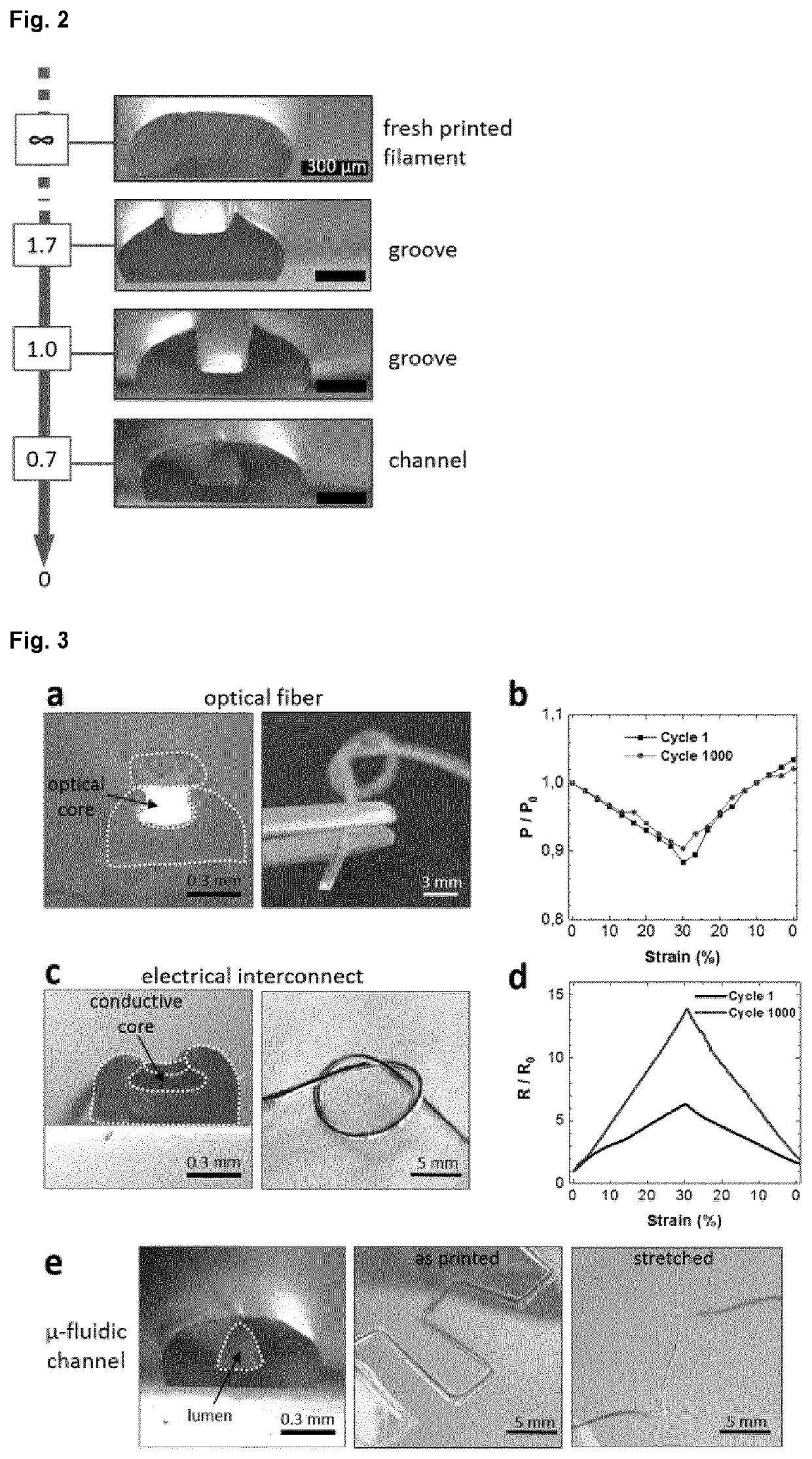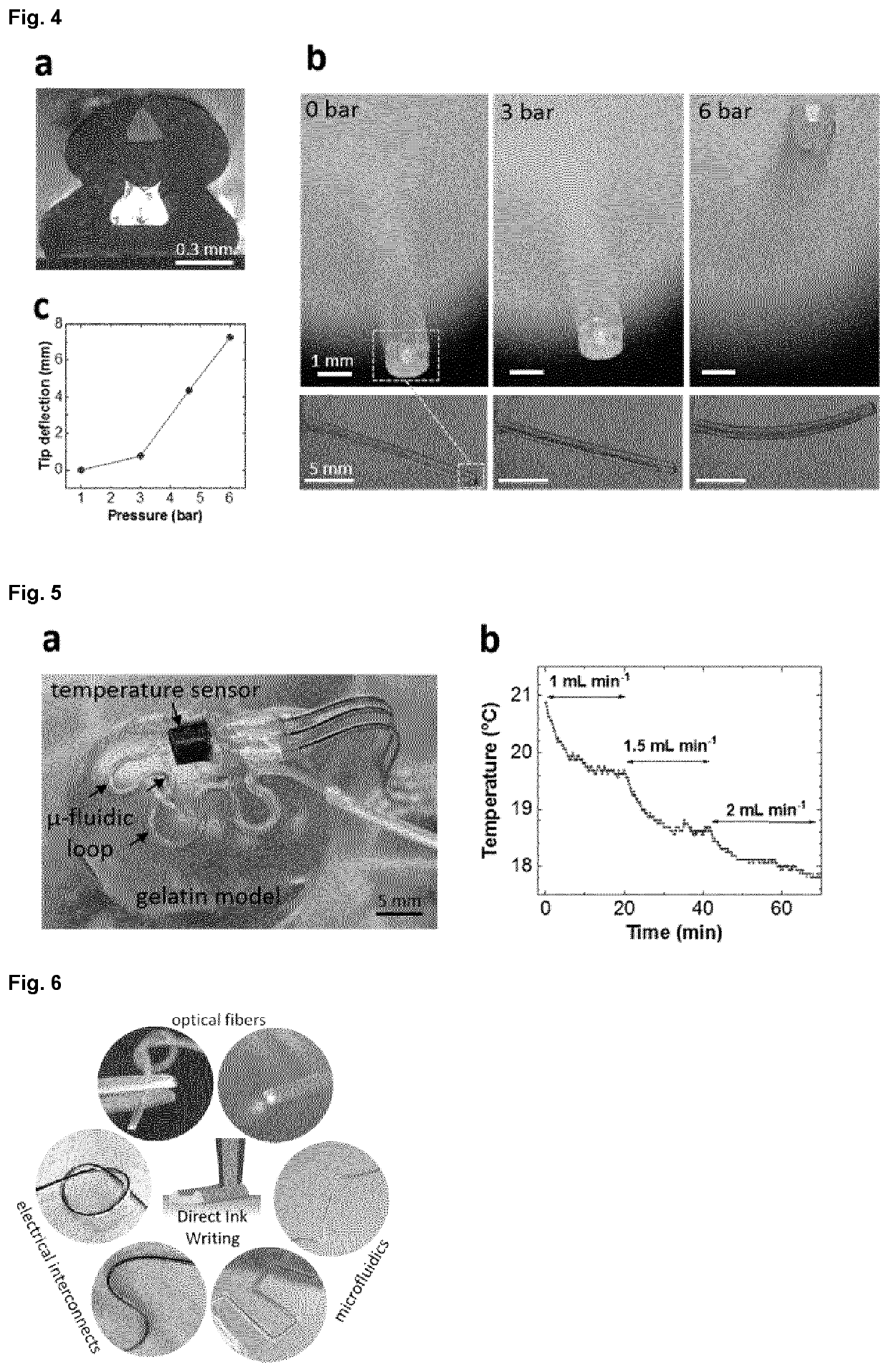Method for producing an elastic and flexible fiber with optical, electrical or microfluidic functionality
- Summary
- Abstract
- Description
- Claims
- Application Information
AI Technical Summary
Benefits of technology
Problems solved by technology
Method used
Image
Examples
example 1
d Velocity Determination
[0151]In standard DIW operations, filaments have close to circular cross sections with diameter αdin. Here din is the inner diameter of the nozzle and α is the die-swelling factor, which describes the post-extrusion expansion of the ink [16]. Stable printing is achieved by setting the translational speed of the print head v to be close to the extrusion speed C, with which ink leaves the nozzle. At the same time, the height of the nozzle above the substrate h is kept similar to αdin (FIG. 1a). Following Yuk and Zhao, we introduce the dimensionless nozzle speed V*≡v / c and height H*≡h / αdin and point out that for conventional DIW with circular cross-section filaments, both parameters are adjusted to be close to unity [15]. The extrusion speed C may depend on the ink, nozzle and applied pressure. For inks that age, C can change over time. Values for C and α can be determined experimentally by printing simple test structures (FIG. 7). In some embodiments, V* and H*...
example 2
usion Modification of the Filament Cross Section
[0156]Post-extrusion modification of the filament cross section is demonstrated below. To do this, we use the nozzle as a stylus by setting to zero (no ink leaves the nozzle). Passing the stylus over a freshly printed (not yet polymerized) ribbon / ellipse filament of SE1700 silicone can create a groove in it (FIG. 2). Interestingly, we observed that engraving deep grooves causes collapse of their walls leaving behind a lumen. The lumen persists even after thermal polymerization of the ink.
Example 3: Functional Core-Shell Fibers
[0157]Next, we combine ribbon and groove filaments to form functional core-shell fibers (FIG. 3). As illustrated in FIG. 3(a), grove filaments can aid patterning a functional core material by restricting its spreading to the confines of the grove. Combined with a ribbon filament printed on top, the grove filaments serve as cladding protecting the core. In the case of conductive fibers, the cladding functions as el...
example 3
l Interconnects
[0160]Similarly, electrical interconnects can be printed by filling groove filaments with a conductive material. Here we use compacted platinum microparticles as the conductive core while the groove and ribbon filaments act as electrical passivation (FIG. 3c). Elastic interconnects produced in this way display average conductivity of 22±3.5 Scm-1 which is similar to the conductivity observed in other metal microparticle based conductive composites [21].
[0161]Electrical interconnects remain conductive when stretched to at least 30% tensile strain (FIG. 3d). Strain of 30% results in 6.80±1.86-fold increase in resistance, which changes to 14.17±2.02 after 1 000 strain cycles. Finally, we demonstrate that using the printing nozzle as a stylus, freeform microfluidic channels can be produced. Printed channels are observed to be free of obstructions (FIG. 3e) and are able to support laminar flow (FIG. 11). The three types of fiber presented here exhibit nearly linear elastic...
PUM
| Property | Measurement | Unit |
|---|---|---|
| Length | aaaaa | aaaaa |
| Length | aaaaa | aaaaa |
| Length | aaaaa | aaaaa |
Abstract
Description
Claims
Application Information
 Login to View More
Login to View More - R&D
- Intellectual Property
- Life Sciences
- Materials
- Tech Scout
- Unparalleled Data Quality
- Higher Quality Content
- 60% Fewer Hallucinations
Browse by: Latest US Patents, China's latest patents, Technical Efficacy Thesaurus, Application Domain, Technology Topic, Popular Technical Reports.
© 2025 PatSnap. All rights reserved.Legal|Privacy policy|Modern Slavery Act Transparency Statement|Sitemap|About US| Contact US: help@patsnap.com



